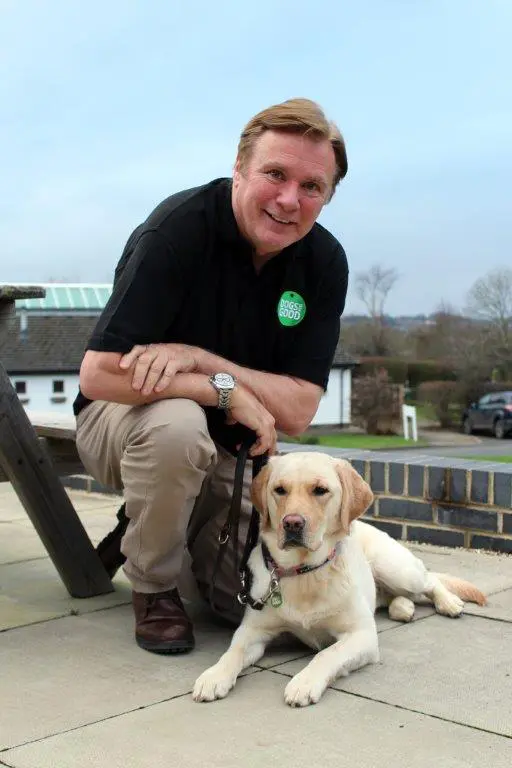
Over the last few months, our staff and volunteers have been working in exceptional circumstances to train and socialise our dogs. As lockdown restrictions are eased a little, we are starting to take our dogs into more public spaces and move a step closer to our goal of being able to proactively match dogs with people on our waiting list.
We spoke to our operations manager, Chris Muldoon to see how things are progressing.
Can you tell us about some of the changes that have been put in place to enable us to train our dogs?
The impact of COVID- 19 has been felt worldwide but like everyone else, we’ve had to make significant changes at a more local level within Dogs for Good. We’ve had to create new working protocols and innovations to meet the circumstances and they have proved to be very successful, due in no small part to the efforts of our volunteers and staff. I am extremely grateful to them for all their hard work and dedication and have been somewhat in awe of the new and exciting ways they have tackled the complexities of working in a new and sometimes difficult environment.
Some things do need to get done and training our dogs is a priority. Doing this safely has meant looking at the issues around picking up and dropping off of dogs, transporting them to places where the trainers can train them and returning them to their boarders. In addition, we have had to spend a lot of time evaluating our dogs to examine any effects of a prolonged period of lockdown on their wellbeing and behaviour.
We have incorporated PPE into our training toolkit and of course, are making sure dogs are handled with even more care and attention to cleanliness. We have also had to rethink the places we can train our dogs and have approached many of our local shopping venues to seek permission to bring dogs safely into their establishments again. To date they have been more than accommodating.
Everything we do now in terms of training takes more time and requires extra thought about how to do it safely and how to measure the success of that process to create long-lasting protocols
Have we been able to pick up where we left off in March?
Prior to lockdown, we had a very clear production schedule, a strategic plan with 2020 as an integral part of that movement and the ability to move freely around the world we live in. Where we are now has seen nearly five months of designing the world we live in to be safe for our volunteers, staff and dogs. This has been a monumental challenge but one we have met head on. The result is that we now have a clear plan to see us to the end of 2020 and beyond, a revised production schedule to meet client needs and new ways of working that ensures that we are still training the best working dogs we can.
Are there any common issues staff are seeing with dogs commencing their training?
Prior to lockdown we had a very robust behavioural assessment strategy to make sure the dogs with the greatest potential for success were mainstreamed into the training programme. Since Covid-19, we have added to that a number of assessment criterion such as signs of separation anxiety, weight gain, reactions to new and unusual phenomenon – such as people wearing face masks as key markers for any behaviour changes. To date, we have been more than satisfied that the work done by our volunteers and staff to minimise these issues has paid off.
What are the biggest challenges for staff, volunteers and dogs?
The biggest challenges since we first heard of Covid-19 was going into lockdown and now, coming out of it.
An organisation like Dogs for Good is heavily dependent on people to make it successful and as such, it has a large turning circle. Changing direction as quickly as we had to was a masterpiece in organisational management and an acceptance of that change from volunteers and staff.
Every detail that was part of our day-to-day activities prior to lockdown had to be factored in to find new ways of working, without compromising the high standards of results we expect.
Where we had clients who needed support, we created new ways of maintaining that interaction with a key element of our service delivery; the personal contact. Where we had staff working from home we had to be innovative with communications and contact. We tackled projects in a way that will add to our understanding and learning and will also make new ways of working very much part of our ‘new normal’ ways of working.
Is there anything that people can do to help if they see our dogs working?
For us, getting back to training our clients and dogs is our primary goal, so when people see our dogs in shops and in the community, we’d ask them to remember this is how we trained before Covid-19, getting our dogs used to working in public spaces is an essential part of their training.
The presence of our clients, volunteers, staff and dogs, out again in the community are signs that Dogs for Good is committed and ready to recommence its vital work and that our volunteers, staff and dogs are all ready to take up the challenge with support from our generous communities.
We rely on donations to continue our life-changing work and since lockdown, donations have dropped dramatically. In addition, we have had to cancel events and collections. Please support us today.
Please donate today.